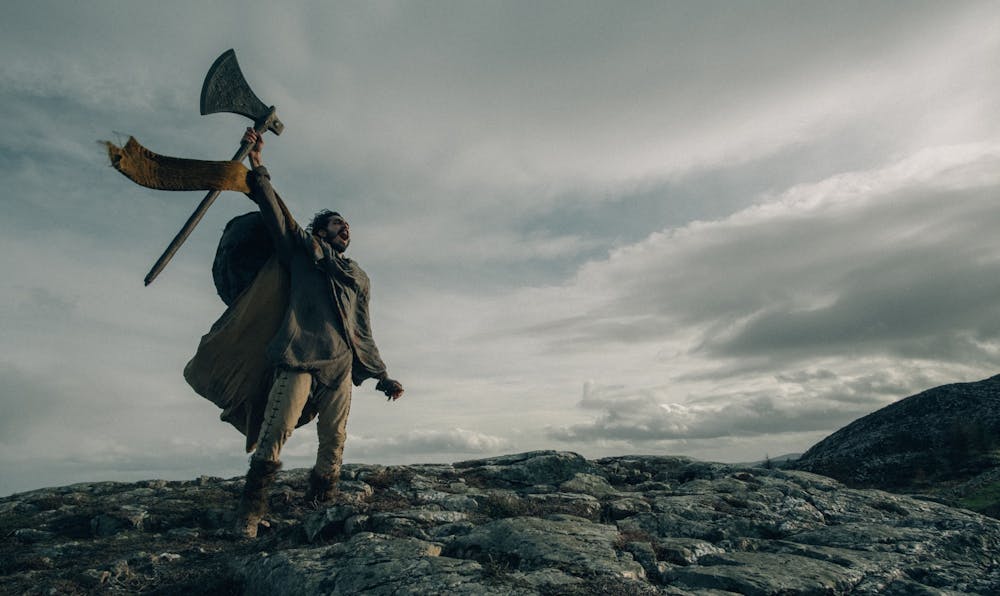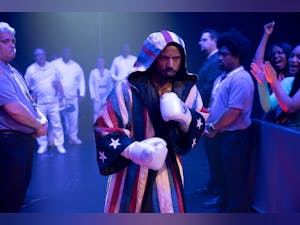From: Silver Screen
REVIEW: ‘The Green Knight’ is a refreshing take on Arthurian legend

Based on a 14th century Arthurian chivalric poem, “The Green Knight”, from writer and director David Lowery, follows the legend of Sir Gawain (Dev Patel) on his quest to seek out the mysterious titular monster.
During a Christmas Day celebration at King Arthur’s fabled Round Table, a strange tree-like human creature on horseback barges in and identifies itself as the Green Knight. He challenges anyone in the court to attempt to land a blow on him in exchange for his axe. But in return, whoever takes up the knight in his game must travel to his home at the Green Chapel the following Christmas to have an equal blow returned on them.
Thus begins our protagonist’s journey for honor: Gawain, a young, inexperienced man of royal blood takes up the challenge, not understanding the full scope of what he’s in for when he decapitates the monster. The Green Knight’s decapitated head laughs as its body picks it up and rides away, knowing Gawain is bound by honor to seek it out in one year’s time.
The movie is definitely a slow burn, but not to the viewer’s displeasure: it is filled with beautiful set pieces that span burnt battlefields, lush forests and peaking mountaintops. And while Andrew Droz Palermo’s cinematography is sure to get some awards buzz, the true standout of the movie is Patel.
Patel’s portrayal of Sir Gawain is a career-defining role for the Oscar-nominated actor. The audience feels the conflict within Patel in each decision he makes: he’s simply a young man torn between his own selfish desires and his duty to family and kingdom.
This inner conflict takes its form in a variety of ways, whether it’s Patel’s body language telling us about his level of certainty in a given situation, or an apparition that comes to chastise him about his own greed. Every step forward carries a visible burden on the protagonist.
Lowery’s Gawain, however, deviates from the original literature; the Gawain of the poem follows the typical depiction of a virtuous knight synonymous with Camelot’s Round Table. But according to Lowery, Gawain isn’t a noble knight as much as he is an immature womanizer who would rather have his epic fate fall into his lap than decide his life for himself.
While aesthetically pleasing, the movie is not for everyone. Some elements that have become a signature of Lowery’s filmmaking, like his unconventional approach to storytelling, are very present in this most recent outing. The line is blurred between reality and illusion, sometimes to a fault. The ambiguity and mystery of this through line in the movie can materialize as confusion for many viewers unfamiliar with the source material — and rightfully so. Not many people are picking up 14th-century British folk poems in their free time.
The Middle English dialogue can also be extremely jarring and takes a while to get used to. The movie tries to stay true to its medieval time period with impressive set and costume design, so at times the conversations between characters can feel like a foreign language.
These aspects of the film may cause it to be a miss for some viewers. The indirect approach Lowery takes with the narrative combined with certain stylistic choices can make the movie fall flat for a lot of viewers by the time they’ve sat through its 2-hour runtime.
“The Green Knight” is a sophisticated tale of chivalry, truth and self determination. While staying true to its genre roots of medieval fantasy, the film leans more on the medieval and less on the fantasy. The movie is an incredibly down-to-earth character study that focuses less on the magical aspects of Arthurian Romance and more on the moral lessons embedded in the medieval British folk tales.
“The Green Knight” is available in theaters now.




